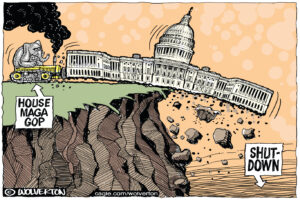After the Recession, Belt-Tightening
This is no time for retrenchment, but the deficit projections coming out of the Congressional Budget Office are alarming and will only get worse if we dawdle.Stop procrastinating. That is always good advice, and always hard to heed. But in some situations procrastination is more damaging than others. One of those involves getting the country’s fiscal health in order. The latest advice to stop procrastinating — or, perhaps more important, the latest explanation of why procrastinating will only make matters worse and the fix that much more painful — comes courtesy of the Congressional Budget Office, and its new report on the long-term budget outlook.
The CBO, like other sensible economic analysts, is not calling for an immediate retrenchment to deal with record deficits — far from it. As the report explains, “With economic activity and employment currently well below the levels that could be achieved by fully utilizing the nation’s labor force and capital stock, raising revenues or curbing spending immediately would probably slow the economic recovery.”
Translation: It’s too soon to hit the brakes.
“However,” the report adds, “the sooner that long-term changes to spending and revenues are agreed on, and the sooner they are implemented after the period of economic weakness, the smaller will be the damage to the economy from rising federal debt.”
Translation: The longer we dawdle, the harder this is going to be.
That might be obvious — although, then again, perhaps not to those who make the case that faster-than-expected economic growth could make the problem evaporate, or slowing the rise of health care spending could make it much less daunting. Perhaps, but that is a dangerous hope on which to rely. I might win the lottery tomorrow, but it’s not a very smart retirement plan.
The CBO report shows why. It looks at the “fiscal gap” — the extent to which government would need to immediately and permanently cut spending, raise taxes or both — in order to stabilize the national debt at its level as a share of the economy at the start of this year. Not that this is anything to be happy about: 53 percent of gross domestic product, a level not seen since shortly after World War II.
Imagine that policymakers want to keep the debt stable through 2035. Assume a realistic policy scenario — most of the Bush tax cuts continue, the alternative minimum tax is adjusted to keep pace with inflation, scheduled cuts in Medicare reimbursements to doctors are canceled.
If the new austerity begins in 2011, it would require an annual increase in revenue or cut in spending equivalent to 4.8 percent of GDP. This would amount to about $715 billion (in 2010 dollars) the first year — more than the entire defense budget. But waiting until 2015 boosts that number to 5.7 percent of GDP, meaning finding $1 trillion of savings that first year. Waiting until 2020 boosts the necessary trims to 7.9 percent of GDP, or a daunting $1.5 trillion the first year alone.
And this calculation does not reflect the true cost of waiting, as the overhang of debt crowds out investment and drives up interest rates. “Incorporating such effects would make the impact of delaying policy changes even more severe,” the report warns.
Once this ugly recession is past, the country is in for an ugly period of belt-tightening. How ugly will depend on how quickly policymakers manage to act.
Ruth Marcus’ e-mail address is marcusr(at symbol)washpost.com.
© 2010, Washington Post Writers Group
Your support matters…Independent journalism is under threat and overshadowed by heavily funded mainstream media.
You can help level the playing field. Become a member.
Your tax-deductible contribution keeps us digging beneath the headlines to give you thought-provoking, investigative reporting and analysis that unearths what's really happening- without compromise.
Give today to support our courageous, independent journalists.






You need to be a supporter to comment.
There are currently no responses to this article.
Be the first to respond.